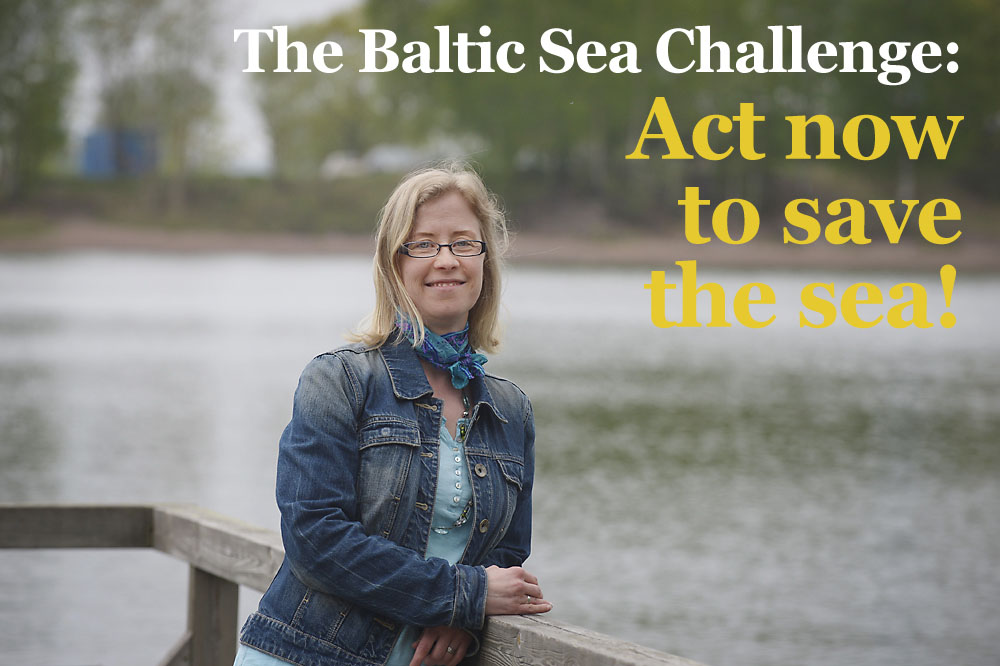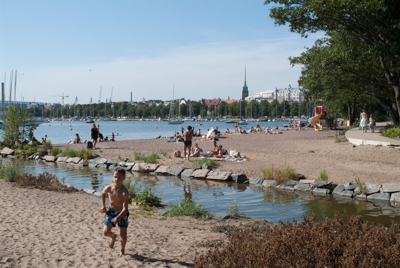
Photo Kimmo Brandt
By Johanna Lemola
“What’s special about the Baltic Sea Challenge is voluntary action by local players and commitments that go beyond regulatory measures,” says Lotta Ruokanen, the co-ordinator of the challenge at the City of Helsinki Environment Centre.
The Challengers, the Cities of Helsinki and Turku urge everyone to act now as the Baltic Sea Challenge moves on to the campaign’s second round.
Underwater rocks literally grow seaweed, floating algae sometimes form rafts, and any object immersed in water becomes slimy. These are aspects that easily catch the eye and rouse the concern of anyone who moves on the Baltic Sea shoreline in the summer. What’s going on?
The explanation is eutrophication – the sea’s response to excessive amounts of nutrients, largely nitrates and phosphates, caused by fertilizers, sewage, traffic and other human activity. The Baltic Sea is already beyond its capacity to absorb the nutrient load that has in many places increased 8-fold in the past 100 years. Hazardous chemicals and threats from fast growing oil tanker transportation add to the sea’s distress.
Governments have noticed and the EU has taken heed, doing what they can through regulatory measures. But much more needs to be done. The cities of Helsinki and Turku, with their mayors at the helm, envisioned a plan in 2007 to do just that. The cities declared the Baltic Sea Challenge, a campaign to help save the sea. They drafted a list of commitments for themselves to improve the state of the sea and challenged others to do the same.
Yes, we can effect positive change!
“What’s special about the Baltic Sea Challenge is voluntary action by local players and commitments that go beyond regulatory measures,” says Lotta Ruokanen. She is Helsinki’s Baltic Sea Challenge co-ordinator at the City of Helsinki Environment Centre, the challenge’s host agency in the city organisation.
“The challenge stems from the understanding that we won’t achieve any real improvement by fulfilling rules that only set minimum standards, and we must go further,” Ruokanen points out.
The Helsinki and Turku action plan drafted in 2007 listed concrete measures – such as reducing loading from the cities’ sewage networks and scattered housing, and curbing agricultural loading from city-owned farms. The cities would accept wastewater from international cruise ships free of charge and build wastewater facilities for smaller boats. Their other commitments focused on international co-operation, research and general awareness building.
The cities’ own efforts might not amount to a great deal, with their wastewater treatment facilities already of top international level, and their farming activities limited. But the main points were setting an example and urging others to act, too.
“The worst problem in the Baltic Sea is diffuse loading,” Ruokanen says. This is loading that comes in bits and pieces, mostly from agriculture and scattered human settlements. As a result, recruiting all levels of actors to join the challenge is all the more important.
Helsinki and Turku have challenged more than 700 actors from across the board, including other communities, national institutions, corporations, non-profit organisations, universities and schools. By now, more than 190 signatories have accepted the challenge, and many of them have drafted their own action plans.
One of the newcomers is the Finnish Rotarians. They envision to make all 12,000 Rotarians in Finland recognise local sources of diffuse loading and take action, in the spirit of the Rotary dedication to service in the community and around the globe.
Other newcomers include Helsinki schools. Spreading the Baltic Sea message to pupils, they educate the future generation of citizens to safeguard the sea.
A new round of challenge
“It became evident to us already in the first phases of the challenge that we had missed one important aspect,” Ruokanen continues. At the end of the list of initial commitments, she has penned oil spill response capacity.
She explains, “Tanker shipments from oil terminals on the Gulf of Finland have increased almost 10-fold in the past two decades. We’re no longer talking about a possibility of an oil spill disaster but a very high likelihood of one.” Oil spills were added to the challenge’s action plan in 2010.
A larger revision of the challenge is underway. Helsinki and Turku are reviewing their efforts so far, and a revised action plan should be in place by the end of September 2013. The new plan will pay more attention to hazardous substances and marine litter.
Importantly, the new plan will focus on active citizenship in Baltic Sea issues.
Moving forward all the time
In her position Ruokanen is in an excellent vantage point to monitor a wide range of efforts to save the Baltic Sea. “Things are happening all the time, larger and smaller, far and wide,” she confirms.
“We mustn’t surrender to the thought that we’re crushed under undefeatable circumstances. We’re moving forward, one step at a time. Everybody can do something within their scope of possibilities.”
The Baltic Sea – a unique but distressed ecosystem
Helsinki waters welcome swimmers, showing major improvement over decades
The Baltic Sea – a unique but distressed ecosystem
The Baltic Sea is a youngster among the world’s seas, formed after the Ice Age less than 15,000 years ago. It is practically an inland water body, and water changes between the Baltic Sea and the saline North Sea only through the narrow and shallow Danish Straits. It takes 30 years for all water in the Baltic Sea to change.
The Baltic Sea is one of the world’s largest bodies of brackish water, with salinity varying from 2.2 percent in the Danish Straits to 0.6 percent in the Gulf of Finland, while the average for the oceans is 3.5 percent. The sea hosts a unique biota adapted to these low and varying salinities.
The Baltic Sea is only 55 metres deep on average, while the average depth of the Mediterranean Sea is 2 kilometres and that of the Atlantic Ocean 4 is kilometres. Furthermore, half of the Baltic Sea area normally has an ice cover for several winter months.
The above facts make the Baltic Sea’s ecology highly vulnerable.
The Baltic Sea is surrounded by 9 countries and the sea’s catchment area is 4 times larger than the sea area. The sea receives effluents from 14 countries and 90 million people. Further, transport on the Baltic Sea is on a continuous increase, and the Gulf of Finland is one of the three busiest maritime regions in the world, together with the English Channel and the Singapore region.
One of the most serious threats to the Baltic Sea is eutrophication due to heavy nutrient loading. Microscopic phytoplankton has increased significantly in the sea, and harmful algal blooms have become prevalent. When algae die and sink to the bottom to decompose, the resulting microbial activity eats up oxygen. Large areas of the sea bottom suffer from nearly complete lack of oxygen, and these areas can no longer maintain maritime life.
Photo City of Helsinki Media Bank

Helsinki waters welcome swimmers, showing major improvement over decades
The City of Helsinki Environment Centre monitors and reports on the water quality and presence of toxic algal blooms at Helsinki’s 26 public swimming beaches throughout the summer swimming season from mid-June to the end of August.
At the end of the season in 2012, the Environment Centre reported that the hygienic quality of water was good at all beaches and no blue algae were detected. The hygienic quality classification is based on the presence of the Enterococci and E. coli bacteria in the water, indicating sewage contamination.
Over the whole summer season, 10 of the 13 large public beaches had excellent water quality, and none of them was classified poor.
This was not always the case at Helsinki beaches. Some decades ago, many beaches in Helsinki were often closed for swimming due to poor water quality.
Coastal waters classified satisfactory to good
Helsinki coastal waters have shown significant improvement over the past four decades.
In the early 1970’s, Helsinki bays were classified poor. Twenty years later, all bays and other coastal waters were classified satisfactory, with the exception of the waters near the mouth of the Vantaa river, where water quality was fair or poor largely due to nutrient loading carried from far inland. By 2006, water quality was fair only near the Vantaa river mouth, while most of the coastal waters were classified satisfactory and the waters at some southern Helsinki shorelines (for example, at the West Harbour) were classified good.
The improvement is largely thanks to efficient wastewater treatment in the Helsinki Metropolitan Area. Wastewaters are now treated at two large and very efficient plants and discharged into the sea many kilometers off the shoreline..
St Petersburg takes strides to improve wastewater treatment
Efficient wastewater treatment is one of the keys to improving the state of the Baltic Sea. Improvements in wastewater treatment capabilities in the Gulf of Finland coastal regions have had a positive impact on the overall state of the gulf. The most notable example is St Petersburg.
In 1998, one-third of the wastewaters of this mega-city were discharged untreated into the Gulf of Finland. Since then, St Petersburg has built and upgraded several new wastewater treatment plants and improved processes, including e.g. efficient phosphorus removal, partially with expert help from Helsinki.
In 2004, St Petersburg was responsible for 40 percent of the phosphorous loading of the Gulf of Finland; today that number is 15.
Photo Raoul Charpentier
